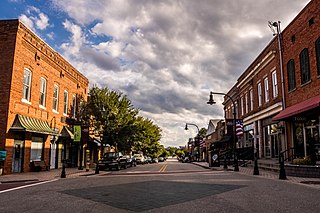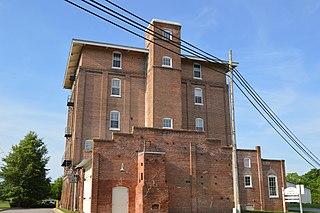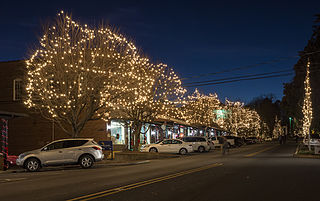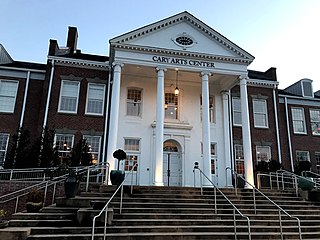
Wake Forest is a town in Wake and Franklin counties in the U.S. state of North Carolina. Located almost entirely in Wake County, it lies just north of the state capital, Raleigh. At the 2020 census, the population was 47,601, up from 30,117 in 2010. It is part of the Raleigh metropolitan area. Wake Forest was the original home of Wake Forest University for 122 years before it moved to Winston-Salem in 1956.
Mill Village Historic District may refer to:

Kendall Mill Historic District is a historic mill complex, mill village, and national historic district located at Camden, Kershaw County, South Carolina. The district encompasses 119 contributing buildings, 1 contributing sites, and 1 contributing structure in Camden. The district is centered on the Wateree Plant and associated structures that date from 1899 to 1923. The mill village to the south and southeast of the plant was built between 1900 and ca. 1925 and is a virtually intact reminder of the importance of the textile industry to South Carolina. The mill faces Kendall Park, a ten-acre landscaped park. On the eastern border of the park are the mill supervisors’ houses, built between 1900 and ca. 1925. The operatives house consist of one-story, 1 1/2-story, and a few two-story frame houses which date from 1900 to 1923. The district also includes Kendall Lake, north of the mill. The Dekalb Cotton Mill was organized in 1899. The Dekalb Mill building, designed by W.B. Smith Whaley in the Romanesque Revival style, was considered a model of textile architecture. The original plant building is a four-story rectangular brick building with a back stair tower and an imposing six-story front stair tower. The west addition to the plant, which is in keeping, architecturally, with the older buildings, was constructed in 1964. It is located in the City of Camden Historic District.

Riverside Industrial Historic District, also known as Asheville Wholesale District, is a national historic district located at Asheville, Buncombe County, North Carolina. The district encompasses 27 contributing buildings and one contributing structure in a predominantly industrial section of Asheville. Notable buildings include the Orpheus and Bertha Keener House, American Feed Milling Company, Italianate style Carolina Coal & Ice Company, Asheville Cotton Mill Cloth Warehouse, Standard Oil Company complex, and Farmers Federation Building.
Bost Mill Historic District is a national historic district located near Georgeville, Cabarrus County, North Carolina. The district encompasses 10 contributing buildings and 3 contributing sites associated with the Bost Mill grain and cotton operation. Notable buildings include the Bost Roller Mill, the John Bost House with its five outbuildings, the Bost Tenant House, the St. Paul's Methodist Church, and the Bost Cotton Gin.

Mount Pleasant Historic District is a national historic district located at Mount Pleasant, Cabarrus County, North Carolina. The district encompasses 98 contributing buildings and 3 contributing structures in the town of Mount Pleasant. It includes residential, institutional, and commercial buildings in a variety of popular architectural styles including Victorian, Colonial Revival, and Bungalow / American Craftsman. Notable buildings include the Jacob Ludwig House, Kindley Mill Village houses, Saint James Evangelical and Reformed Church, Lutheran Church of the Holy Trinity, Mount Pleasant Milling Company, Kindley Cotton Mill, and Tuscarora Cotton Mill.

Edenton Cotton Mill Historic District is a national historic district located at Edenton, Chowan County, North Carolina. The district encompasses 70 contributing buildings, 1 contributing site, 2 contributing structures, and 1 contributing object in a small mill village. It includes industrial and residential buildings developed between 1899 and 1923. Residential buildings are primarily simple one-story, single-pile, frame dwellings and some examples of the Bungalow / American Craftsman style. Notable non-residential buildings include the Italianate Revival style Edenton Cotton Mill (1899-1916), Edenton Cotton Mill Office, and First Christian Church (1916).
Cooleemee Mill Town Historic District is a national historic district located at Cooleemee, Davie County, North Carolina. The district encompasses 433 contributing buildings, 1 contributing site, and 6 contributing structures on the original Cooleemee Cotton Mill Company property at Cooleemee. It was developed between 1898 and 1967, and includes notable examples of Gothic Revival, American Craftsman, and Colonial Revival style architecture. Notable contributing resources include the mill houses of 12 house types, Cooleemee Cotton Mill complex, Pest House and the company farm, Friendship Baptist Church, North Cooleemee Elementary School (1952), Church of the Good Shepherd (1925), Cooleemee United Methodist Church (1932), First Baptist Church of Cooleemee (1949), Cooleemee Recreation Center Bathhouse (1949), “The Holler,” and “Riverside Park,” also known as “Park Hill.”

McAdenville Historic District is a national historic district located at McAdenville, Gaston County, North Carolina. It encompasses 93 contributing buildings, 2 contributing sites, and 7 contributing structures in the mill village associated with McAden Mills, a cotton mill chartered by the state legislature in 1881. The buildings were built between about 1884 and 1959, and include notable examples of Late Victorian and Italianate architecture. Notable buildings include 15 brick mill worker houses, remnants of McAden Mill No. 1 (1881–82) and McAden Mill No. 2 (1884–85), McAden Mill No. 3 (1906–07), and Pharr Corporate Offices redesigned by Earle Sumner Draper.

Highland Cotton Mills Village Historic District is a historic mill village and national historic district located at High Point, Guilford County, North Carolina. The district encompasses 177 contributing buildings and 1 contributing structure. They include the two mills and the shipping and packing building at the Highland Cotton Mills, the Highland Cotton Mills Office, the Highland Methodist Church and its parsonage, the Johnson Farm House.

Hawkins Avenue Historic District is a national historic district located at Sanford, Lee County, North Carolina. It encompasses 200 contributing buildings and 4 contributing structures in a predominantly residential section of Sanford. The district includes notable examples of Colonial Revival and Queen Anne style architecture, with buildings largely dated between about 1900 to the 1930s. Located in the district is the separately listed Sanford High School, Former. Other notable buildings include the John McIver House (1880s), Duncan E. McIver House (1893), Malcolm D. McNeill House, E.L. Gavin House (1922), First Presbyterian Church of Sanford (1914), First Baptist Church (1925), the former Sanford Cotton Mill complex, and the Liles Bonded Cotton Warehouse.

Rocky Mount Mills Village Historic District is a national historic district located at Rocky Mount, Nash County, North Carolina. It encompasses 101 contributing buildings and 2 contributing structures in a historic mill village located at Rocky Mount. The buildings primarily date between about 1835 and 1948, and include notable examples of Greek Revival and Bungalow / American Craftsman style residential architecture. The district includes the buildings previously listed as Rocky Mount Mills and includes the Colonel Benjamin D. Battle House (1835). Other notable buildings include the mill village community house (1918) and a variety of one- and two-story frame mill worker houses.

Villa Place Historic District is a national historic district located at Rocky Mount, Nash County, North Carolina. It encompasses 321 contributing buildings and 1 contributing structure in a residential section of Rocky Mount. The buildings primarily date between about 1900 and 1950, and include notable examples of Queen Anne, Colonial Revival, Classical Revival, and Bungalow / American Craftsman style residential architecture. Located in the district is the separately listed Machaven. Other notable buildings include the W.D. Cochran House, Mills-Watson House, Aladdin Homes Company "kit houses," the James Craig Braswell School (1940), Draine Confectionery, and West End Grocery.

Coleridge Historic District is a national historic district located at Coleridge, Randolph County, North Carolina. The district encompasses 17 contributing buildings in the Victorian mill village of Coleridge. It includes buildings built between 1882 and the late 1920s and notable examples of Queen Anne and Romanesque Revival architecture. Notable buildings include the Enterprise Cotton Mill complex, the company store, mill office, Bank of Coleridge, and John Caveness House.

Spray Industrial Historic District is a national historic district located at Eden, Rockingham County, North Carolina. It encompasses 70 contributing buildings, 9 contributing structures, and 1 contributing object in an industrial section of the town of Eden. It includes buildings associated with eight textile mill complexes, mill village housing, and seven commercial buildings. Notable contributing resources include the Smith River Dam and Spray Power canal, Morehead Cotton Mill complex, "Superintendent's" House, Imperial Bank and Trust Company (1912), Leaksville Cotton Mills complex, Spray Mercantile Building, Spray Cotton Mills complex, Lily Mill complex, Nantucket Mills complex designed by R. C. Biberstein, American Warehouse Company complex, Rhode Island Mill complex, Phillips-Chatham House, and Spray Woolen Mill complex.

Carpenter Historic District is a national historic district located near Cary, Wake County, North Carolina. The districts encompasses 66 contributing buildings, 1 contributing site, and 8 contributing structures in the rural crossroads community of Carpenter. The district developed between about 1895 and 1933, and includes notable examples of Late Victorian and Colonial Revival style architecture. Notable buildings include the Carpenter Farm Supply Company, D. Judson Clark Machine/Garage, Byrd-Ferrell House, Mallie and Cora Butts Farm, A.M. Howard Farm, and Barbee-Williams Farm.

Cary Historic District is a national historic district located at Cary, Wake County, North Carolina. The district encompasses 39 contributing buildings in a predominantly residential section of Cary. The district developed between about 1890 and 1945, and includes notable examples of Queen Anne and Bungalow / American Craftsman style architecture. Notable buildings include the former Cary High School built in 1939 by the Works Progress Administration, Esther Ivey House, Captain Harrison P. Guess House, and Dr. John P. Hunter House.
Wake Forest Historic District is a national historic district located at Wake Forest, Wake County, North Carolina. The district encompasses 245 contributing buildings, one contributing site, and five contributing structures built between about 1890 and 1953 and located in the historic core of the town of Wake Forest. It includes notable examples of Greek Revival and Federal style architecture. Located in the district are the separately listed Lea Laboratory, South Brick House, and the Powell-White House, a contributing resource in the Glen Royall Mill Village Historic District. Other notable buildings include the historic campus of Wake Forest College, Wake Forest Baptist Church (1913), Magnolia Hill (1928), Calvin Jones House, John M. Brewer House, Wait-Taylor House (1843), Taylor-Purefoy-Poteat-Swett House, Community House, St. Catherine of Siena Catholic Church, the Powers Store (1897), and former Water and Light Building (1909).
Downtown Wake Forest Historic District is a national historic district located at Wake Forest, Wake County, North Carolina. The district encompasses 25 contributing buildings, 1 contributing structure, and 1 contributing object built between about 1890 and 1949 and located in the central business district of the town of Wake Forest. It includes notable examples of Colonial Revival and Art Deco style architecture. Notable buildings include the Lovelace Building (1940s), Dick Frye Restaurant (1940s), Powers-Barbee Building, Wilkinson Building (1899), B&S Department Store, Arrington Building (1915), Bank of Wake (1895), Wake Forest Post Office (1914), Collegiate Theater (1915), and Wake Forest Post Office (1940).
Royall Cotton Mill Commissary is a historic commercial building associated with the Royall Mill and located at Wake Forest, Wake County, North Carolina. It built in 1900, and is a two-story, rectangular brick building with a low gabled metal roof and stepped parapet. It measures 32 feet by 100 feet and has segmental arched windows. The Royall Cotton Mill Commissary closed in 1934. The building has been rehabilitate into apartments.

















